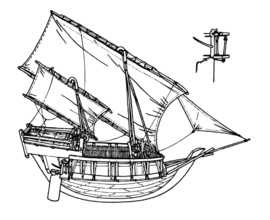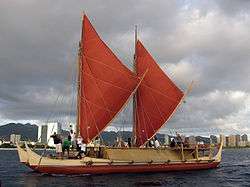Benawa
Benawa or banawa is a type of ship from Gowa, an old principality in the southwest corner of Sulawesi, Indonesia. The earliest record of this vessel is from Hikayat Banjar, which has been written gradually from 14th-17th century.[1] In the present, the type is already extinct; pelari and paduwakan, vessels with similar hull, have taken its place.[2]

Etymology
The word benawa or banawa comes from kawi Javanese language, which means boat or ship.[3] In old Javanese language and Malay language the meaning is more or less the same.[4] In different language, the word may refer to different type of vessel, depending on the context of the sentence.[5]
Description
The benawa was specially made for the transport of horses and buffaloes. The hull was broad in beam with convex keel, with stempost and sternpost running high up. On both sides an outboard fore and aft gangway is attached to a number of crossbeams which are secured to the bulwark. The secondary function of these beams is to divide the deckspace into an equal compartments for the cattle. The upper deck covering the "stable" consist of bamboo lattice.[2][6]
It is steered with 2 quarter rudders, which are fixed to a set of heavy crossbeams in a way to enable a quick emergency release. The helmsmen stood on the outboard galleries. There is a cramped cabin for the captain below the poop deck. The vessel has 2 to 3 masts, both were tripod with the rear legs fixed to heavy tabernacles by means of a horizontal spar round which they can revolve. If the foreleg comes adrift from the hook that holds it in place, the mast can be lowered easily. The sails are tanja and made with karoro matting.[6] With European influence in the latter centuries, western-styled sails can also be used. In the past, Makassarese sailor may sail them as far as New Guinea and Singapore.[2]
See also
- Toop
- Padewakang
- Jong
- Golekan
References
- Johannes Jacobus Ras (1968). Hikajat Bandjar. A study in Malay historiography. OCLC 38909.
- H. H. Frese. (1956). Small Craft in the Rijksmuseum voor Volkenkunde, Leiden. The Mariner's Mirror. 42 : 2, 101-112.
- Maharsi (2009). Kamus Jawa Kawi Indonesia. Yogyakarta: Pura Pustaka.
- Petrus Josephus Zoetmulder, 1982, Old Javanese – English Dictionary, The Hague: Martinus Nijhoff. 2 v. (xxxi, 2368 p.) In collaboration with S.O. Robson.
- Rafiek, M. (December 2011). "Ships and Boats in the Story of King Banjar: Semantic Studies". Borneo Research Journal. 5: 187–200.
- G. E. P. Collins, East Monsoon (London, I936); Makassar Sailing (London, 1937); 'Seafarers of South Celebes', The National Geographic Magazine, Washington, January I945·


.jpg)